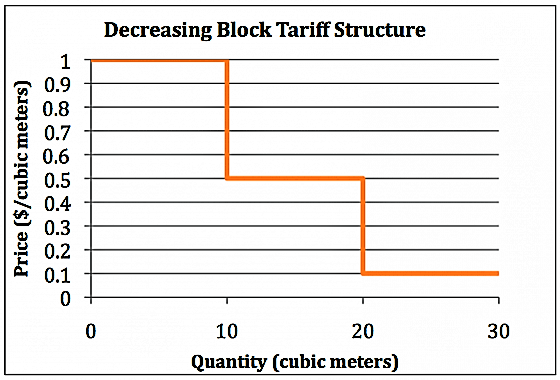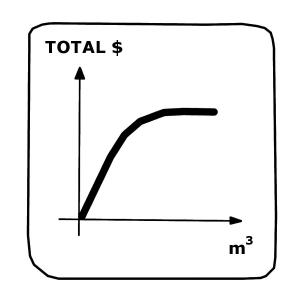Executive Summary
Water and wastewater tariffs determine the level of revenues that service providers receive from users in centralised or semi-centralised systems for the appropriate catchment, purification and distribution of freshwater, and the subsequent collection, treatment and discharge of wastewater. Water pricing is seen as an important economic instrument for improving water use efficiency, enhancing social equity and securing financial sustainability of water utilities and operators. Tariff setting practices vary widely around the world. Here, the advantages and disadvantages of decreasing block tariffs as a type of volumetric water charge are discussed.
Block Tariffs
Block tariffs are volumetric charges. The prerequisite for setting a volumetric charge is that consumers have a metered connexion to water services. Under a block tariff scheme, users pay different amounts for different consumption levels. Block tariffs have a step-wise structure. The water charge is set per unit (e.g. cubic meters) of water consumed and remains constant for a certain quantity of consumption (first block). As the water use increases, the tariff shifts to the next block of consumption and so on for each block of consumption until the highest one. Block tariffs can be differentiated among consumer categories (e.g. domestic and non-domestic) and are of two main types: increasing and decreasing.
Decreasing Block Tariffs
With decreasing block tariffs,the rate per unit of water is high for the initial (lower) block of consumption and decreases as the volume of consumption increases.
This type of tariff structure was designed because “when raw water supplies are abundant, large industrial customers often impose lower average costs because they enable the utility to capture economies of scale in water source development, transmission, and treatment. Also, industrial users typically take their supplies from the larger trunk mains, and thus do not require the expansion of neighbourhood distribution networks” (WHITTINGTON 2002).
Well-designed decreasing block tariffs allow utilities to recover costs. However, they penalise consumers with low level of consumption and provide a disincentive for reducing wastage of water. There is a trend to move out of these kind of tariffs, essentially because water conservation has found place in the political agenda of many governments and marginal costs of providing water are now relatively high in many countries, hence decreasing block tariff are not any more profitable for utilities. Decreasing block price scheme are still used in some communities of the USA and Canada, though in recent years other volumetric tariffs (e.g. uniform price and increasing block) are more frequently applied.
Design Principles of a Decreasing Block Tariff
In order to design an decreasing block structure, the regulator must decides for each category of water use:
- The number of blocks.
- The volume of water use associated with each block.
- The prices to be charged for water use within these blocks.

See also other types of water pricing:
- general information on water pricing
- fixed water charge
- water pricing increasing block tariffs
- water pricing uniform volumetric charge
The decreasing block tariff can be applied everywhere where water is provided and/or wastewater is collected. A metering system is required. Block tariffs can be set at the service provider level or by national or local government. However, this type of tariff is not regarded to be sustainable from a social or ecological point of view, as those who consume least (usually the poor) have to pay the highest price per unit. Furthermore, this tariff encourages consuming more instead of less water, which can put limited water resources under pressure.
Financing and Cost Recovery
This paper provides an excellent overview on financing and cost recovery for the water supply and sanitation services sector in rural and low-income urban areas of developing countries. The document contains also case studies and mini reviews of best publications on financing and cost recovery.
CARDONE, R. FONSECA, C. (2003): Financing and Cost Recovery. Delft (The Netherlands): IRC (International Water and Sanitation Centre). Thematic Overview Paper 7. URL [Accessed: 03.05.2019]Tariffs and Subsidies in South Asia: Understanding the Basics
Municipal Water Pricing and Tariff Design: a Reform Agenda for South Asia
This paper describes the major elements of a package of pricing and tariff reforms that are needed in the municipal water supply sector in many South Asian cities. Keywords: Increasing block tariffs; Pro-poor policies; Seasonal tariffs; Subsidies; Tariff designs; Water pricing.
WHITTINGTON, D. (2003): Municipal Water Pricing and Tariff Design: a Reform Agenda for South Asia. In: Water Policy 5 : , 61–76. URL [Accessed: 20.07.2010]Pricing Water and Sanitation Services. Human Development Report 2006. Human development office-occasional paper
The purpose of this paper is to provide the reader with a better understanding of the main issues involved in the design of W&S tariffs. Keywords: Costs of W&S services, objectives of tariff design, tariff options, subsidies, development paths of W&S services.
WHITTINGTON, D. (2006): Pricing Water and Sanitation Services. Human Development Report 2006. Human development office-occasional paper. New York: UNDP URL [Accessed: 03.05.2019]Pricing Water and Sanitation Services. Human Development Report 2006. Human development office-occasional paper
The purpose of this paper is to provide the reader with a better understanding of the main issues involved in the design of W&S tariffs. Keywords: Costs of W&S services, objectives of tariff design, tariff options, subsidies, development paths of W&S services.
WHITTINGTON, D. (2006): Pricing Water and Sanitation Services. Human Development Report 2006. Human development office-occasional paper. New York: UNDP URL [Accessed: 03.05.2019]Financing and Cost Recovery
This paper provides an excellent overview on financing and cost recovery for the water supply and sanitation services sector in rural and low-income urban areas of developing countries. The document contains also case studies and mini reviews of best publications on financing and cost recovery.
CARDONE, R. FONSECA, C. (2003): Financing and Cost Recovery. Delft (The Netherlands): IRC (International Water and Sanitation Centre). Thematic Overview Paper 7. URL [Accessed: 03.05.2019]Providing Water to the Urban Poor in Developing Countries: The Role of Tariffs and Subsidies
This brief explores the role of water tariffs and subsidies as key instrument to achieve the objective of providing safe and affordable drinking water to residents of growing urban areas in developing countries.
BLANC, D. le (2007): Providing Water to the Urban Poor in Developing Countries: The Role of Tariffs and Subsidies. In: Sustainable Development Innovation Brief: Volume 4 URL [Accessed: 03.05.2019]A Framework for Analyzing Tariffs and Subsidies in Water Provision to Urban Households
This paper aims to present a basic conceptual framework for understanding the main practical issues and challenges relating to tariffs and subsidies in the water sector in developing countries. The paper introduces the basic economic notions relevant to the water sector; presents an analytical framework for assessing the need for and evaluating subsidies; and discusses the recent evidence on the features and performance of water tariffs and subsidies in various regions, with a special focus on Africa. The discussion is limited to the provision of drinking water to urban households in developing countries.
BLANC, D. le (2008): A Framework for Analyzing Tariffs and Subsidies in Water Provision to Urban Households . New York: DESA Working Paper n°63 URL [Accessed: 20.07.2010]Water is an Economic Good: How to use Prices to Promote Equity, Efficiency, and Sustainability
This paper focuses on the role of prices in the water sector and how they can be used to promote equity, efficiency, and sustainability.
ROGERS, P. ; SILVA, R. de ; BATHIA, R. (2001): Water is an Economic Good: How to use Prices to Promote Equity, Efficiency, and Sustainability. In: Water Policy : Volume 4 , 1–17. URL [Accessed: 03.05.2019]Municipal Water Pricing and Tariff Design: a Reform Agenda for South Asia
This paper describes the major elements of a package of pricing and tariff reforms that are needed in the municipal water supply sector in many South Asian cities. Keywords: Increasing block tariffs; Pro-poor policies; Seasonal tariffs; Subsidies; Tariff designs; Water pricing.
WHITTINGTON, D. (2003): Municipal Water Pricing and Tariff Design: a Reform Agenda for South Asia. In: Water Policy 5 : , 61–76. URL [Accessed: 20.07.2010]International Statistics for Water Services
This short leaflet presents water international statistics for water services, e.g. major cities’ water bills, abstraction sources for drinking water supplies, or a large comparison of water cycle charges.
IWA SPECIALIST GROUP STATISTICS AND ECONOMICS (2010): International Statistics for Water Services. The Hague: International Water Association (IWA). [Accessed: 22.04.2012] PDFWater and Sanitation
The website of UN DESA (UN Department of Economic and Social Affaires) contains a section dedicated to water issues, including publications about water tariffs and subsidies in the provision of water services in developing countries.
World Water Assessment Programme (UNESCO WWAP)
The website of the World Water Assessment Program (WWAP) serves as a thematic entry point to the current UNESCO and UNESCO-led programmes on freshwater. It offers a review of case studies to highlight the challenges that need to be addressed in the water resources sector including water-pricing issues.


